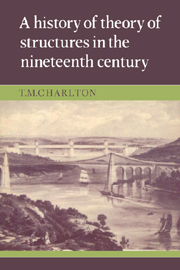Book contents
- Frontmatter
- Contents
- Preface
- 1 Introduction
- 2 Beam systems
- 3 Theory of the arch and suspension bridge
- 4 Elementary theory of frameworks: graphical statics
- 5 Theory of statically-indeterminate frameworks: the reciprocal theorem
- 6 Levy's theory of frameworks and bridge girders
- 7 Early developments of energy principles relating to theory of structures
- 8 The later development and use of energy principles
- 9 Applications of the least work principle: elastic theory of suspension bridges
- 10 Aspects of the further development of theory of structures
- 11 Secondary effects in structures
- Appendices
- Bibliography
- Name index
- Subject index
11 - Secondary effects in structures
Published online by Cambridge University Press: 18 September 2009
- Frontmatter
- Contents
- Preface
- 1 Introduction
- 2 Beam systems
- 3 Theory of the arch and suspension bridge
- 4 Elementary theory of frameworks: graphical statics
- 5 Theory of statically-indeterminate frameworks: the reciprocal theorem
- 6 Levy's theory of frameworks and bridge girders
- 7 Early developments of energy principles relating to theory of structures
- 8 The later development and use of energy principles
- 9 Applications of the least work principle: elastic theory of suspension bridges
- 10 Aspects of the further development of theory of structures
- 11 Secondary effects in structures
- Appendices
- Bibliography
- Name index
- Subject index
Summary
For the purpose of this chapter, secondary effects are understood to include dynamic stresses as well as those which arise from the nature of construction details, especially the rigidity of joints (connections) in triangulated trusses (bridge girders). The term secondary stress is usually associated with these latter, following the initiative of Professor Asimont of the Munich Polytechnikum in 1877. In that year a prize was offered by the Polytechnikum (as noted in Chapter 1) for a method of calculating those stresses in trusses (termed Sekundarspannung by Asimont, to distinguish them from the stresses due to the axial or primary forces in the bars, that is, Hauptspannung). Dynamic stresses, on the other hand, became the subject of research in the nineteenth century, due to the failure of a number of iron railway bridges, which were caused by the passage of trains.
Secondary stresses
According to Grimm (1908), Asimont formulated the problem of secondary stresses in rigidly-jointed trusses and suggested that, since the resultants no longer pass through the panel points, a solution might be afforded by ‘Euler's equation of the elastic line’. In the event, the prize was awarded in 1879 to Professor Manderla and his solution was published soon afterwards (1880), although an approximate solution by Engesser in which chords were treated as continuous and web members as pin-jointed, appeared a year earlier (1879).
- Type
- Chapter
- Information
- A History of the Theory of Structures in the Nineteenth Century , pp. 157 - 163Publisher: Cambridge University PressPrint publication year: 1982

